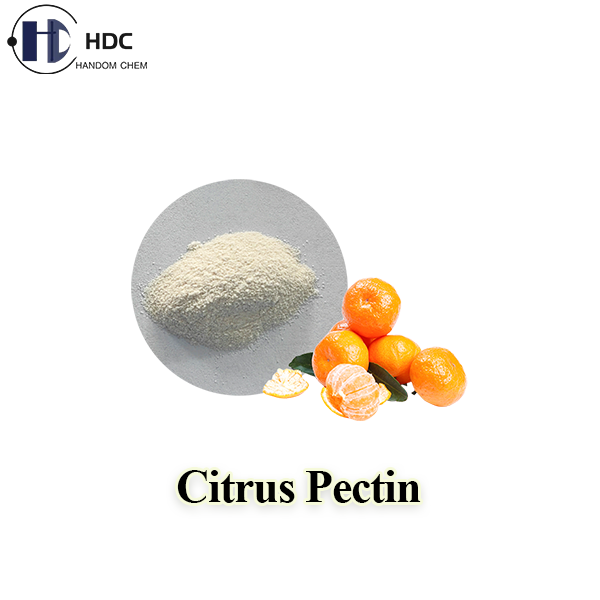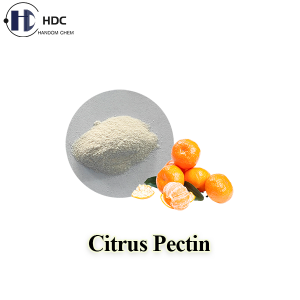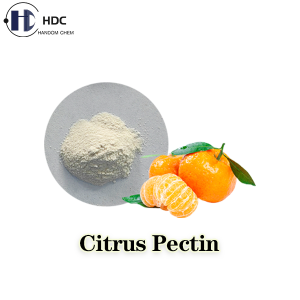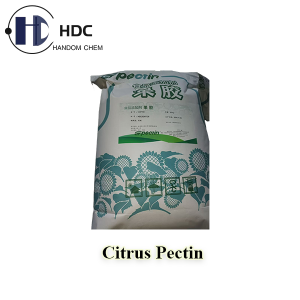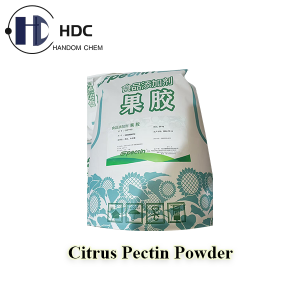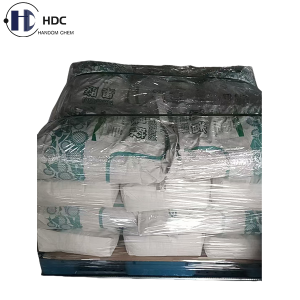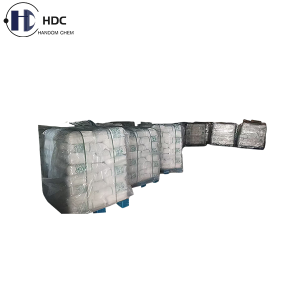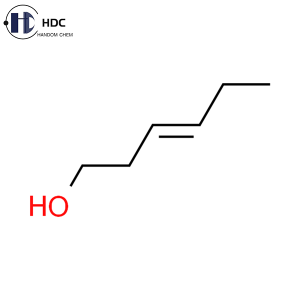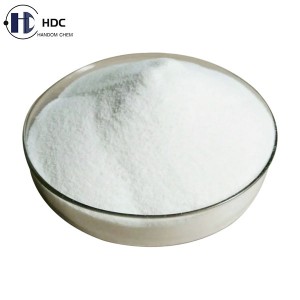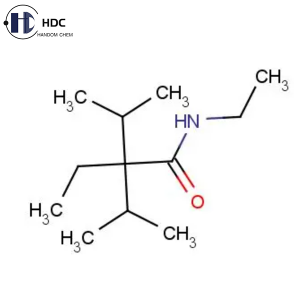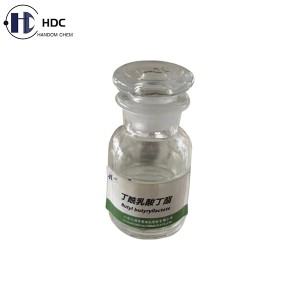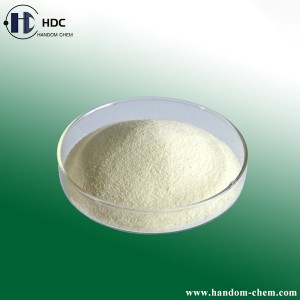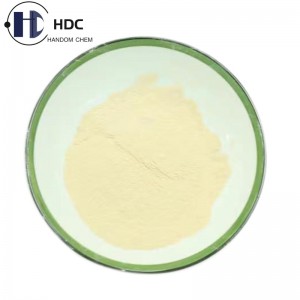Citrus Pectin
Brief Introduction:
Citrus pectin, the abbreviation is CP, which is a polysaccharide complex extracted from the peel and pulp of citrus, lemon, orange, and grapefruit. Its molecule exists in a long-chain carbohydrate structure with a molecular weight of 50,000~300,000 Da and an esterification degree between 20% and 75%.
Natural citrus pectin is generally used as a food additive, with good gelling, stabilizing, emulsifying, thickening, and suspending functions.
As a pure natural water-soluble dietary fiber without any toxic side effects, citrus pectin plays a very important role in healthy food.
Composition & Molecular Structure of Citrus Pectin:
Citrus pectin is mainly composed of galacturonic acid and is a polysaccharide complex. Its molecular structure includes straight chains and branched chains, and has a high degree of esterification, which gives it good gelling and stabilizing properties.
Specifications of our Citrus Pectin(CCP705):
| Test Items | Specifications |
| Appearance | White, pale yellow to brown free-flowing powder |
| Odour/Taste | Neutral |
| pH Value (1% solution) | 2.8 ~ 3.8 |
| Degree of Esterification | 58% ~ 62% |
| Grade USA SAG | >200 |
| Galacturonic Acid | ≥65% |
| Loss on Drying (105℃, 2h) | ≤12% |
| Acid-insoluble Ash | ≤1% |
| Sulfur Dioxide (SO2) | ≤10 mg/kg |
| Free methyl, ethyl and isopropyl alcohol | ≤1% |
| Lead (Pb) | ≤2 mg/kg |
| Total Plate Count | ≤1000 CFU/g |
| Yeast & Mould | ≤100 CFU/g |
| Coliforms | Negative/g |
| Escherichia coli | Negative/g |
| Staphylococcus aureus | Negative/25g |
| Salmonella | Negative/25g |
Specifications of our Citrus Pectin(CCP712):
| Test Items | Specifications |
| Appearance | White, pale yellow to brown free-flowing powder |
| Odour/Taste | Neutral |
| pH Value (2% solution) | 2.8 ~ 3.8 |
| Degree of Esterification | 69% ~ 72% |
| Grade USA SAG | 145 ~ 155 |
| Galacturonic Acid | ≥65% |
| Loss on Drying (105℃, 2h) | ≤12% |
| Acid-insoluble Ash | ≤1% |
| Sulfur Dioxide (SO2) | ≤10 mg/kg |
| Free methyl, ethyl and isopropyl alcohol | ≤1% |
| Lead (Pb) | ≤2 mg/kg |
| Total Plate Count | ≤1000 CFU/g |
| Yeast & Mould | ≤100 CFU/g |
| Coliforms | Negative/g |
| Escherichia coli | Negative/g |
| Staphylococcus aureus | Negative/25g |
| Salmonella | Negative/25g |
Specifications of our Citrus Pectin(CCP713):
| Test Items | Specifications |
| Appearance | White, pale yellow to brown free-flowing powder |
| Odour/Taste | Neutral |
| pH Value (2% solution) | 2.8 ~ 3.8 |
| Degree of Esterification | 66% ~ 69% |
| Grade USA SAG | 145 ~ 155 |
| Galacturonic Acid | ≥65% |
| Loss on Drying (105℃, 2h) | ≤12% |
| Acid-insoluble Ash | ≤1% |
| Sulfur Dioxide (SO2) | ≤10 mg/kg |
| Free methyl, ethyl and isopropyl alcohol | ≤1% |
| Lead (Pb) | ≤2 mg/kg |
| Total Plate Count | ≤1000 CFU/g |
| Yeast & Mould | ≤100 CFU/g |
| Coliforms | Negative/g |
| Escherichia coli | Negative/g |
| Staphylococcus aureus | Negative/25g |
| Salmonella | Negative/25g |
Specifications of our Citrus Pectin(CCP714):
| Test Items | Specifications |
| Appearance | White, pale yellow to brown free-flowing powder |
| Odour/Taste | Neutral |
| pH Value (2% solution) | 2.8 ~ 3.8 |
| Degree of Esterification | 62% ~ 66% |
| Grade USA SAG | 145 ~ 155 |
| Galacturonic Acid | ≥65% |
| Loss on Drying (105℃, 2h) | ≤12% |
| Acid-insoluble Ash | ≤1% |
| Sulfur Dioxide (SO2) | ≤10 mg/kg |
| Free methyl, ethyl and isopropyl alcohol | ≤1% |
| Lead (Pb) | ≤2 mg/kg |
| Total Plate Count | ≤1000 CFU/g |
| Yeast & Mould | ≤100 CFU/g |
| Coliforms | Negative/g |
| Escherichia coli | Negative/g |
| Staphylococcus aureus | Negative/25g |
| Salmonella | Negative/25g |
Specifications of our Citrus Pectin(CCP715):
| Test Items | Specifications |
| Appearance | White, pale yellow to brown free-flowing powder |
| Odour/Taste | Neutral |
| pH Value (2% solution) | 2.8 ~ 3.8 |
| Degree of Esterification | 58% ~ 62% |
| Grade USA SAG | 145 ~ 155 |
| Galacturonic Acid | ≥65% |
| Loss on Drying (105℃, 2h) | ≤12% |
| Acid-insoluble Ash | ≤1% |
| Sulfur Dioxide (SO2) | ≤10 mg/kg |
| Free methyl, ethyl and isopropyl alcohol | ≤1% |
| Lead (Pb) | ≤2 mg/kg |
| Total Plate Count | ≤1000 CFU/g |
| Yeast & Mould | ≤100 CFU/g |
| Coliforms | Negative/g |
| Escherichia coli | Negative/g |
| Staphylococcus aureus | Negative/25g |
| Salmonella | Negative/25g |
Specifications of our Citrus Pectin(CCP721):
| Test Items | Specifications |
| Appearance | White, pale yellow to brown free-flowing powder |
| Odour/Taste | Neutral |
| pH Value (2% solution) | 2.8 ~ 3.8 |
| Degree of Esterification | >69% |
| Viscosity (4% solution) | 400 mPa·s ~ 500 mPa·s |
| Galacturonic Acid | ≥65% |
| Loss on Drying (105℃, 2h) | ≤12% |
| Acid-insoluble Ash | ≤1% |
| Sulfur Dioxide (SO2) | ≤10 mg/kg |
| Free methyl, ethyl and isopropyl alcohol | ≤1% |
| Lead (Pb) | ≤2 mg/kg |
| Total Plate Count | ≤1000 CFU/g |
| Yeast & Mould | ≤100 CFU/g |
| Coliforms | Negative/g |
| Escherichia coli | Negative/g |
| Staphylococcus aureus | Negative/25g |
| Salmonella | Negative/25g |
Specifications of our Citrus Pectin(CCP771B):
| Test Items | Specifications |
| Appearance | White, pale yellow to brown free-flowing powder |
| Odour/Taste | Neutral |
| pH Value (2% solution) | 4.0 ~ 5.0 |
| Degree of Esterification | 58% ~ 64% |
| Grade Confectionery | 160±7 |
| Buffer Capacity | 0.5 ~ 0.8 |
| Galacturonic Acid | ≥65% |
| Loss on Drying (105℃, 2h) | ≤12% |
| Acid-insoluble Ash | ≤1% |
| Sulfur Dioxide (SO2) | ≤10 mg/kg |
| Free methyl, ethyl and isopropyl alcohol | ≤1% |
| Lead (Pb) | ≤2 mg/kg |
| Total Plate Count | ≤1000 CFU/g |
| Yeast & Mould | ≤100 CFU/g |
| Coliforms | Negative/g |
| Escherichia coli | Negative/g |
| Staphylococcus aureus | Negative/25g |
| Salmonella | Negative/25g |
Applications of our Citrus Pectin (CP):
1) Food Field:
Citrus pectin is an important gelling agent and stabilizer, commonly used in making a variety of foods such as jelly, cakes, biscuits, desserts, etc. It can increase the viscosity of food and improve the texture and taste of food (citrus pectin helps to improve the color, texture and shelf life of candy products; in baked products such as cakes and pastries, the gelling properties of pectin also help prevent fruit from discoloring and drying out.)
2) Medical Field:
① Sustained-release Drugs:
Citrus pectin has good water solubility and adhesion, which can slow down the release rate of drugs and prolong the duration of drug efficacy.
② Preparation of Capsules:
Citrus pectin can be processed into microspheres or films, etc., which can be used to encapsulate small molecule drugs or cosmetic ingredients and made into oral or topical capsules.
3) Cosmetics Field:
Citrus pectin can be used as an emulsifier, thickener and softener, etc. It has good moisturizing and softening effects on the skin.
4) Feed Industry:
Citrus pectin can also be used as a feed additive to improve the adhesion and fluidity of feed.
The Uses and Dosages of our Main Models:
♔ Citrus Pectin (CCP705):
It is mainly used as a gelling agent in confectionery and high sugar jams.
Recommended Additive Amount: ① Confectionery: 0.8% ~ 2.0%; ② High Sugar Jams: 0.2% ~ 0.8%
♔ Citrus Pectin (CCP712):
It is mainly used as a gelling/thickening agent in high sugar jams or juice drinks.
Recommended Additive Amount: ① High Sugar Jams: 0.3% ~ 1.0%; ② Juice Drinks: >0.01%
♔ Citrus Pectin (CCP713):
It is mainly used as a gelling/thickening agent in high sugar jams or juice drinks.
Recommended Additive Amount: ① High Sugar Jams: 0.3% ~ 1.0%; ② Juice Drinks: >0.01%
♔ Citrus Pectin (CCP714):
It is mainly used as a gelling agent in confectionery and high sugar jams.
Recommended Additive Amount: ① Confectionery: 1.0% ~ 2.5%; ② High Sugar Jams: 0.3% ~ 1.0%
♔ Citrus Pectin (CCP715):
It is mainly used as a gelling agent in confectionery and high sugar jams.
Recommended Additive Amount: ① Confectionery: 1.0% ~ 2.5%; ② High Sugar Jams: 0.3% ~ 1.0%
♔ Citrus Pectin (CCP721):
It is mainly used as a thickening agent in juice drinks.
Recommended Additive Amount: 0.01% ~ 0.5% (Juice Drinks)
♔ Citrus Pectin (CCP771B):
It is mainly used as a gelling agent in confectionery.
Recommended Additive Amount: 1.0% ~ 2.5% (Confectionery)
Packaging:
500g/Aluminum Foil Bag, 1kg/Aluminum Foil Bag, 25kg/Paper-Plastic Composite Bag or according to the specific requirements from customers.
Storage Conditions:
Preserved in unopened original containers in a cool dry place before using; kept away from direct sunlight, heat and moisture.
Shelf Life:
24 months from the date of production if stored in accordance with the above conditions.


